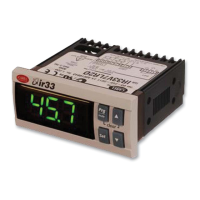
Do you have a question about the Carel IR Series and is the answer not in the manual?
| Display | LCD |
|---|---|
| Type | Controller |
| Communication | Modbus |
| Series | IR Series |
| Category | Controller |
Overview of the IR series' main features, including range, flexibility, and serial connection capabilities.
Detailed description of the controller's front panel components, including display, LEDs, and buttons.
Critical warnings regarding installation environment and cable management to ensure proper operation and safety.
Describes the Direct operation mode, focusing on set-point and differential parameters for temperature control.
Details the factory-default Reverse mode, explaining set-point and differential for temperature control.
Explains the Dead-Zone mode, defining neutral zone and its effect on Direct and Reverse actions.
Describes the PWM mode, detailing its parameters and proportional control action for devices like heaters.
Explains the Alarm mode, covering parameters for general, high, and low temperature alarms, and relay behavior.
Details how digital input 1 selects between Direct and Reverse modes based on its state.
Explains Direct mode with set-point and differential changes driven by digital input status.
Describes Reverse mode with set-point and differential changes controlled by digital input status.
Details Mode 9 for models W and Z, allowing independent Direct and Reverse set-points with the same sensor.
Instructions on accessing and modifying parameters using the instrument's keypad, including password entry.
Procedure for modifying the primary set-point (St1) using the keypad, including value adjustment and confirmation.
Guide to modifying the secondary set-point (St2) for modes requiring two set-points, via keypad.
Steps for modifying frequently used parameters (P-type) like differential, using the keypad.
Procedure for modifying configuration parameters (C-type) via keypad, requiring password access.
Specific C parameters for input types like thermocouples, current, and voltage sensors, including C13, C15, C16.
Detailed steps to change the operating mode (CO parameter) via keypad, including password and mode selection.
Overview of the remote control's functionality for programming and parameter modification.
Instructions for modifying parameters using the remote control, with and without access code.
Procedure for restoring the controller to its factory-set configuration by cutting power and pressing PRG.
Description of the primary set-point (St1), its access modes via keypad/remote, validity, and operating range.
Description of the secondary set-point (St2), its access modes, validity, and special operating conditions.
Description of parameter P1, defining the hysteresis for Set Point 1, its access modes, validity, and operating range.
Explains parameter P3, defining the neutral zone for Modes 3, 4, and 5, its access modes, validity, and operating range.
Description of parameter C4 (authority) used for offset compensation, detailing its formula and access modes.
Parameter C7 defines the minimum time between successive energizations of the same output, useful for compressor management.
Parameter C9 sets the minimum on-time for an output, preventing oil migration in semi-hermetic compressors.
Parameter C11 manages output priority rotation, swapping active/inactive outputs based on their last state.
Parameter P14 allows sensor calibration by adding an offset to the measured value for accurate readings.
Parameter C16 sets the maximum value for current and voltage inputs, defining the upper limit of the measurement range.
Parameter C23 sets the minimum selectable value for the secondary set-point (St2).
Parameter C18 allows selection of temperature units between Celsius (°C) and Fahrenheit (°F).
Describes the differential operation mode using a second NTC sensor for comparison with the primary sensor.
Parameter C22 sets the maximum selectable value for the primary set-point (St1), including offset effects.
Parameter C23 sets the minimum selectable value for the secondary set-point (St2).
Parameter P25 defines the absolute threshold for the low temperature alarm, including delay and relative set-point options.
Parameter P26 defines the absolute threshold for the high temperature alarm, including delay and relative set-point options.
Parameter C29 configures the function of digital input 1, for alarm or ON/OFF control, with options for reset and delay.
Parameter C31 determines the output status (ON/OFF) when a digital input alarm (Er3) occurs, respecting time delays if specified.
Parameter C33 enables advanced customization by allowing access to 16 additional special parameters (C34-C49).
Parameter DEPENDENCE (C34, C38, C42, C46) defines the specific function of each output (control or alarm).
Parameter TYPE OF OUTPUT (C35, C39, C43, C47) specifies if an output is ON-OFF (0) or PWM/TIMER (1).
Parameter ENERGIZATION (C36, C40, C44, C48) defines the energization point as a percentage of the differential or cycle time.
Explains how parameter P3 defines a neutral zone, affecting output hysteresis in special modes.
Details the analogue output module (CONV0/10A0) for converting PWM signals to 0-10Vdc or 4-20mA analogue outputs.
Describes the ON/OFF module (CONVONOFFO) for converting 10Vdc signals to relay outputs, useful for SSR control.
Specifications for the remote control unit, including power supply, case, dimensions, operating temperature, and transmission type.
Wiring diagrams specific to IR32 models with NTC sensor inputs, showing connections for different power supplies.
Wiring diagrams for IR32 models with Pt100, J/K thermocouple, or Voltage/Current inputs.
Wiring diagrams for IRDR models (IRDRTE, IRDRV, IRDRW) with various sensor inputs and power supplies.
Diagrams illustrating how to connect different types of sensors (Pt100, Tc, V/I) to the IR32 and IRDR controllers.